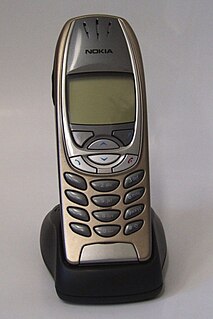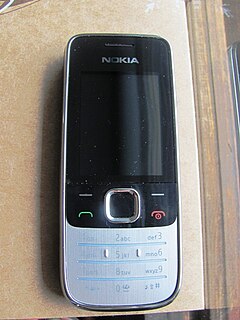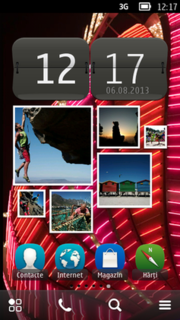Related Research Articles
Java Platform, Micro Edition or Java ME is a computing platform for development and deployment of portable code for embedded and mobile devices. Java ME was formerly known as Java 2 Platform, Micro Edition or J2ME. As of December 22, 2006, the Java ME source code is licensed under the GNU General Public License, and is released under the project name phoneME.
A MIDlet is an application that uses the Mobile Information Device Profile (MIDP) of the Connected Limited Device Configuration (CLDC) for the Java ME environment. Typical applications include games running on mobile devices and cell phones which have small graphical displays, simple numeric keypad interfaces and limited network access over HTTP. MIDlet can run on Android devices via the J2ME Loader emulator application.
Mobile Information Device Profile (MIDP) is a specification published for the use of Java on embedded devices such as mobile phones and PDAs. MIDP is part of the Java Platform, Micro Edition framework and sits on top of Connected Limited Device Configuration (CLDC), a set of lower level programming interfaces. MIDP was developed under the Java Community Process. The first MIDP devices were launched in April 2001.
The Connected Limited Device Configuration (CLDC) is a specification of a framework for Java ME applications describing the basic set of libraries and virtual-machine features that must be present in an implementation. The CLDC is combined with one or more profiles to give developers a platform for building applications on embedded devices with very limited resources such as pagers and mobile phones. The CLDC was developed under the Java Community Process as JSR 30 and JSR 139.

Freedom of Mobile Multimedia Access (FOMA) is the brand name of the W-CDMA-based 3G telecommunications services being offered by the Japanese telecommunications service provider NTT DoCoMo. It is an implementation of the Universal Mobile Telecommunications System (UMTS) and was the world's first 3G mobile data service to commence commercial operations.

Binary Runtime Environment for Wireless is an application development platform created by Qualcomm, originally for code division multiple access (CDMA) mobile phones, featuring third-party applications such as mobile games. It is offered in some feature phones but not in smartphones. First developed in 1999, as a platform for wireless applications on CDMA-based mobile phones, it debuted in September 2001. As a software platform that can download and run small programs for playing games, sending messages, and sharing photos, the main advantage of Brew MP is that the application developers can easily port their applications among all Brew MP devices by providing a standardized set of application programming interfaces. Software for Brew MP enabled handsets can be developed in C or C++ using the freely downloadable Brew MP software development kit (SDK). The BREW runtime library is part of the wireless device on-chip firmware or operating system to allow programmers to develop applications without needing to code for system interface or understand wireless applications. BREW is described as a pseudo operating system, but not a true mobile operating system. BREW is not a virtual machine such as Java ME, but it runs a native code.
OMA SpecWorks, previously the Open Mobile Alliance (OMA) is a standards organization which develops open, international technical standards for the mobile phone industry. It is a nonprofit Non-governmental organization (NGO), not a formal government-sponsored standards organization as is the International Telecommunication Union (ITU): a forum for industry stakeholders to agree on common specifications for products and services.
The Mobile Media API (MMAPI) is an API specification for the Java ME platform CDC and CLDC devices such as mobile phones. Depending on how it's implemented, the APIs allow applications to play and record sounds and video, and to capture still images. MMAPI was developed under the Java Community Process as JSR 135.
The Sun Java Wireless Toolkit is a toolbox for developing wireless applications that are based on JavaME's Connected Limited Device Configuration (CLDC) and Mobile Information Device Profile (MIDP), and designed to run on cell phones, personal digital assistants, and other small mobile devices. The toolkit includes the emulation environments, performance optimization and tuning features, documentation, and examples.
The Motorola A1000 is a 3G smartphone from Motorola. It uses the Symbian 7.0 operating system, enhanced with the UIQ 2.1 platform. One of the phone's most notable features is its built-in A-GPS. The A1000 is the successor to the A925 and A920.
Java Application Descriptor (JAD) files describe the MIDlets that are distributed as JAR files. JAD files are commonly used to package Java applications or games that can be downloaded to mobile phones. Java applications enable mobile phones to interact functionally with online web services, such as the ability to send SMS messages via GSM mobile Internet or interact in multiplayer games. Some BlackBerry devices use JAD files for themes, while on some mobile phones without memory cards it is not possible to download any apps.

The Samsung SGH-D807 is a mobile phone manufactured by Samsung Electronics. It is the third model in the Samsung's mobile phone 'D' series
Wireless Application Protocol (WAP) is a technical standard for accessing information over a mobile wireless network. A WAP browser is a web browser for mobile devices such as mobile phones that use the protocol. Introduced in 1999, WAP achieved some popularity in the early 2000s, but by the 2010s it had been largely superseded by more modern standards. Almost all modern handset internet browsers now fully support HTML, so they do not need to use WAP markup for web page compatibility, and therefore, most are no longer able to render and display pages written in WML, WAP's markup language.

The Nokia 6120 classic is a mid-range smartphone from Nokia that was announced on 17 April 2007. It runs on Symbian v9.2 with a S60 3rd Edition FP1 user interface.

The Nokia 6310i is a mobile phone from Nokia first introduced at the CeBIT fair in March 2002 with sales starting later that year and discontinued in late 2005, it was Nokia's first tri-band phone offering. Primarily marketed as a business phone, it was for some years the dominant GSM device in the corporate world. The device was most commonly offered in Two-tone Silver/Grey or Two-tone Gold/Black trim; the third option, a Copper coloured variant, was much rarer.
ThunderHawk is a discontinued web browser from Bitstream available for a full range of operating systems in high end and mass-market mobile phones and personal digital assistants. It is basically meant for mobile operators and original equipment manufacturers and not meant to download for normal users.
The phoneME project is Sun Microsystems reference implementation of Java virtual machine and associated libraries of Java ME with source, licensed under the GNU General Public License.

The Nokia 2730 classic is a Nokia Quad-band GSM/UMTS 3G cell phone that includes a camera, FM radio, Bluetooth, music and video player, as well as several internet-based applications.

Symbian is a discontinued mobile operating system (OS) and computing platform designed for smartphones. Symbian was originally developed as a proprietary software OS for PDAs in 1998 by the Symbian Ltd. consortium. Symbian OS is a descendant of Psion's EPOC, and was released exclusively on ARM processors, although an unreleased x86 port existed. Symbian was used by many major mobile phone brands, like Samsung, Motorola, Sony Ericsson, and above all by Nokia. It was also prevalent in Japan by brands including Fujitsu, Sharp and Mitsubishi. As a pioneer that established the smartphone industry, it was the most popular smartphone OS on a worldwide average until the end of 2010, at a time when smartphones were in limited use, when it was overtaken by iOS and Android. It was notably less popular in North America.

The Nokia Asha platform is a mobile operating system (OS) and computing platform designed for low-end borderline smartphones, based on software from Smarterphone which was acquired by Nokia. The platform inherits UI similarities mostly from MeeGo "Harmattan", and replaces Series 40 on Nokia's low-end devices. The user interface design team was headed by Peter Skillman, who had worked previously on webOS and the design of MeeGo for the Nokia N9.
References
- 1 2 DoCoMo FAQ on Star Archived January 22, 2011, at the Wayback Machine
- ↑ iAppli profiles, NTT DoCoMo Archived March 24, 2011, at the Wayback Machine